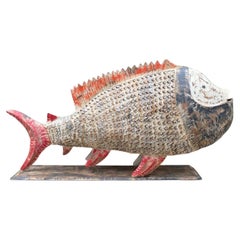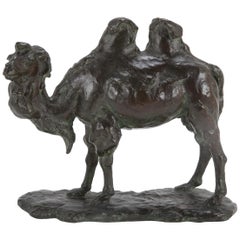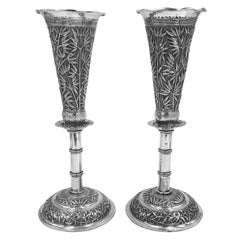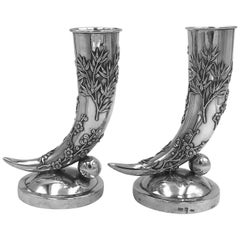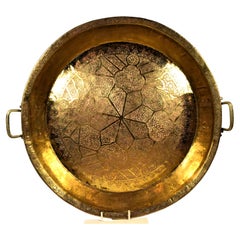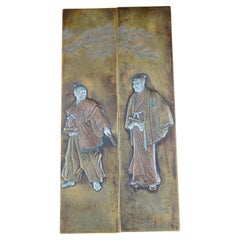Asian Metalwork
to
252
958
385
1,533
12
3
23
10
8
5
5
3
3
1
1
1
118
708
707
15
366
151
47
36
6
16
7
7
4
21
4
3
2
1,523
565
326
263
259
1,548
1,140
639
458
189
1,548
1,545
1,548
17
17
14
6
4
Place of Origin: Asian
Very Decorative Late 20th Century Large Metal Hand Painted Model of a Fish
Located in Petworth,West Sussex, GB
A very decorative large coloured painted metal fish with candleholder. This beautiful fish made by a Jodhpur ironworker is painted and patinated by hand. Wonderful decorative object,...
Category
Late 20th Century Asian Metalwork
Materials
Metal, Iron
A Japanese Bronze of a Bactrian Camel
Located in Stamford, CT
A sculpted Japanese bronze of a Bactrian camel.
Category
Early 1900s Showa Antique Asian Metalwork
Materials
Bronze
Pair of Chinese Export Silver Vases
Located in London, GB
Pair of Chinese silver vases with all-over bamboo decoration and each with a wavy-edge flared rim. They were made by 涂茂兴, TuMaoXing, a retailer in JiuJiang (九江), next to the Yangtze ...
Category
1890s Chinese Export Antique Asian Metalwork
Materials
Silver
Two Chinese Export Silver Vases
By Wang Hing & Co.
Located in London, GB
Two Chinese silver vases of cornucopia form, both decorated with applied bamboo and chrysanthemum and on a circular base. The vases are similar yet were made by different silversmith...
Category
Late 19th Century Chinese Export Antique Asian Metalwork
Materials
Sterling Silver
Islamic Calligraphic Rice Pan "Parat", 20th Century
Located in Islamabad, PK
This culinary masterpiece, designed for the preparation of rice, transcends its utilitarian purpose and becomes a work of art in its own right. The entire surface of the rice pan is adorned with intricately engraved calligraphy, adding a touch of elegance and cultural significance.
The brass rice pan is substantial, reflecting its purpose as a tool for large-scale cooking. Its sheer size and sturdy construction make it a standout piece in any kitchen or culinary setting. The brass material provides a warm and lustrous backdrop for the detailed engravings that grace its surface.
The calligraphy on the rice pan is a testament to the artistry and precision of the craftsman. Delicate Arabic or Persian script, characterized by flowing lines and elegant curves, covers the entire exterior of the pan. The calligraphy may feature verses from poetry, blessings, or traditional sayings related to food, hospitality, and prosperity. Each inscription is meticulously engraved, creating a visually striking contrast between the polished brass and the finely detailed letters.
The combination of the monumental size, brass material, and engraved calligraphy transforms this rice pan into a cultural artifact that goes beyond its culinary function. It becomes a symbol of tradition, craftsmanship, and the importance of communal gatherings around food. Whether displayed as a piece of art or used in the preparation of meals, this monumental brass rice pan stands...
Category
20th Century Islamic Asian Metalwork
Materials
Brass
Japanese Meiji Period Mixed Metal Pair of Scroll Weights Depicting Samurai
Located in Sarasota, FL
Japanese Meiji period fine pair of scroll weights decorated with shakudo and silver samurai figures. The weights fill solid and heavy. One of the weights has Japanese writing ( see i...
Category
19th Century Meiji Antique Asian Metalwork
Materials
Metal
A Meiji bronze vase by Nobuhira
Located in Lymington, Hampshire
A Meiji bronze vase by Nobuhira, of baluster shape with a spirally twisted neck, the body decorated with four high relief crabs and several partially...
Category
1890s Meiji Antique Asian Metalwork
Materials
Bronze
Antique Indian Hindu Bronze Statue Krishna – 18th Century Asian Folk Art
Located in London, GB
Antique Indian Hindu Bronze Sculpture – Krishna with Flute (18th Century)
A captivating and finely crafted antique bronze figure depicting Lord Krishna, rendered in the distinctive ...
Category
19th Century Antique Asian Metalwork
Materials
Silver
Japanese Bronze Kappa
Located in PARIS, FR
Dark brown patina bronze figure of a standing kappa with its right leg leaning on a cucumber. The figure is put on four-legged rattan-like bronze stand.
The kappa (??) is a aquatic creature taken from Japanese folklore having the appearance of an anthropomorphic turtle.
His skull is either slightly hollowed out to accommodate water, from which it derives its power, or hidden with a water lily leaf hiding this sag. Naturally polite, it is advisable to bow to him in order that it should do so in return, thus losing all the water he has gathered and leaving it harmless.
Kappa has the reputation of attempting to lure both humans and animals into the water. In some areas, it ravages fields, stealing eggplants and cucumbers. Some people prefer to worship it and give it offerings rather than be its victims.
Signed Shokaken (???). His real name is Ôshima Yasutarô. He was born in 1849 and is the third generation of a metalworkers family. Together with his brother Ôshima Joun...
Category
Late 19th Century Antique Asian Metalwork
Materials
Bronze
Turkmenistan Antique Tea Copper Caraf Named "Aftabeh"
Located in Alessandria, Piemonte
Rare antique copper caraf for water or tea, named "aftabeh" from Bokara, in Turkmenistan -
Very old, but I perfectly cleaned. Interesting item with a good price.
O/5306 -
Category
Late 18th Century Other Antique Asian Metalwork
Materials
Copper
South Asian Brass Oil Lamp
Located in Chicago, IL
This 20th century South Asian oil lamp is made of brass in the shape of an aircraft. Oil lamps like these were likely handcrafted using the century old lost-wax process of metal cast...
Category
20th Century Asian Metalwork
Materials
Brass
19th Century Chinese Shang Dynasty Bronze Liquor Jug Fengding He Type
Located in LEGNY, FR
Exceptional reproduction of a he type liquor Jug in bronze of the Shang Dynasty (17th-11th century BC). This bronze jug trypod represent a owl's head.
We...
Category
19th Century Antique Asian Metalwork
Materials
Bronze
Chinese Export Silver Beaker, circ 1890's
By Wang Hing & Co.
Located in Sarasota, FL
Chinese export repousse beaker, circ 1890. Wieght 3.3 oz., 4 3/8" tall
Category
Late 20th Century Chinese Export Asian Metalwork
Materials
Silver
Group of Fourteen Japanese Meiji Period Gilt Metal Plaques
Located in London, GB
Group of fourteen Japanese Meiji period gilt metal plaques
Japanese, Late 19th Century
Height 2cm, width 2cm
These beautiful Japanese Meiji period plaque...
Category
Late 19th Century Meiji Antique Asian Metalwork
Materials
Metal
Set of Three Japanese Bronze Vases
Located in Schellebelle, BE
Set of three Japanese bronze vases
Measures: high 27 cm diameter 9 cm
high 27 cm diameter 7 cm
high 21 cm diameter 7 cm.
Category
21st Century and Contemporary Asian Metalwork
Archaic Bronze Vessel in Flattened Flask Form
Located in Stamford, CT
An archaic bronze vessel in flattened flask form with ring handles and mottled red and green patination.
Category
15th Century and Earlier Antique Asian Metalwork
Materials
Bronze
Japanese Bronze Vase
Located in Stamford, CT
A Japanese patinated bronze vase of outstanding color with a lotus bud form top.
Category
19th Century Antique Asian Metalwork
Materials
Bronze
Chinese Silver Repousse Dragon Handle Sauce Boat by Luen Wo
By Luen Wo
Located in Sarasota, FL
Chinese Export silver repousse sauce boat with dragon handles. Marked for Luen Wo.. Very fine decoration. 7 1/4" long, 4 " tall, 3 1/2", 7 oz weight.
Category
1890s Chinese Export Antique Asian Metalwork
Materials
Silver
Fragment of Bronze Head of Buddha, Thailand
Located in Schellebelle, BE
Fragment of Bronze Head of Buddha
Thailand
16th Century
Category
16th Century Antique Asian Metalwork
Materials
Bronze
Chinese Floral Cast Iron Mortar and Pestle
Located in Chicago, IL
This vintage cast iron mortar and pestle from is from China's Shanxi province and is patterned in low relief with floral motifs. It...
Category
Mid-20th Century Asian Metalwork
Materials
Iron
Pair of Bronze Bracelets, Southeast Asia
Located in Schellebelle, BE
Nice pair of Bronze Bracelets,Southeast Asia
11-13th Century
Category
15th Century and Earlier Antique Asian Metalwork
Materials
Bronze
Antique circa 1920 Chinese Export Floor Standing Bell with Wrought Iron Stand
Located in West Sussex, Pulborough
We are delighted to offer for sale this exquisite circa 1920 Chinese Export floor standing bell on wrought iron stand
A very well made and decorative...
Category
1920s Chinese Export Vintage Asian Metalwork
Materials
Brass, Wrought Iron
Chinese Export Silver Dragon Repousse Tanakard
Located in Sarasota, FL
Chinese Export silver tankard with detailed repousse dragons and dragon handle.
The tankard is 5 3/4" tall, 3 1/4' in diameter, 4 1/8" at the handle....
Category
19th Century Chinese Export Antique Asian Metalwork
Materials
Silver
Rare Samarkanda or Bokara Almoner Trays
Located in Alessandria, Piemonte
Very antique and rare almoner trays from Samarkanda or Bokara - Ghaznevide Dinasty from 11th-12th century A.D.
Interesting for Your desk!
From private collection -
O/1655.
Category
15th Century and Earlier Other Antique Asian Metalwork
Materials
Copper
Pair of Meiji Period Solid Silver Bowls by Eigyoku
Located in Lymington, Hampshire
A pair of Meiji period solid silver bowls by Eigyoku, each of lobed oval form on four scroll feet, deeply embossed with continuous chrysanthemum hea...
Category
1910s Meiji Vintage Asian Metalwork
Materials
Silver
Bow Tie Chair in Mirror Finish Stainless Steel by Zhoujie Zhang
By Zhang Zhoujie
Located in Beverly Hills, CA
The bow tie chair is a perfect example of Zhoujie’s philosophy of actionless. Like a force of an airplane, polymerizing inward and flowing with natural ...
Category
21st Century and Contemporary Asian Metalwork
Materials
Stainless Steel
Chinese Export Silver Dragon Repousse Centerpiece
By Zee Sung
Located in Sarasota, FL
Chinese Export Silver Centerpiece with dragon decoration. The centerpiece bowl has two repousse dragons with attached dragon handles. The bowl rests on...
Category
Early 20th Century Chinese Export Asian Metalwork
Materials
Silver
Necklace of Cultured Pearls, Extra Quality 'Akoya Japan'
Located in Madrid, ES
Beautiful necklace of cultured pearls, extra quality (Akoya Japan) and amethysts.
11 mm diameter Secure clasp and 18k golden silver hinges. Long: 50 cm.
Category
20th Century Modern Asian Metalwork
Materials
Gold
Necklace of Cultured Pearls, Extra Quality 'Akoya Japan'
Located in Madrid, ES
Beautiful necklace of cultured pearls, extra quality (Akoya Japan) and amethysts.
Measure: 11 mm diameter Secure clasp and 18k golden silver hinges. Long: 50 cm.
Category
20th Century Modern Asian Metalwork
Materials
Gold
Japanese Pounded Bronze Finial
Located in Hudson, NY
In the shape of kaede leaves. Used on top of a large festival cart carried through the streets.
Category
Early 18th Century Antique Asian Metalwork
Materials
Bronze
Antique Chinese Silver Gilt, Agate & Enamel Censer
Located in New York, NY
Chinese silver censer, circa 1910. Drum-form agate body set in silver gilt mounts with scrollwork and lunettes. Leaf-capped side bracket handles. Upward tapering support and stepped ...
Category
Early 20th Century Qing Asian Metalwork
Materials
Agate, Silver, Enamel
A most unusual silver and gold leaf cloisonné vase by Sukiku, 1981
Located in Lymington, Hampshire
A most unusual silver and gold leaf cloisonné vase by Sukiku, 1981, the ovoid body decorated in abstract designs with wispy silver shapes and moriage gold leaf scattered over a mottl...
Category
1980s Vintage Asian Metalwork
Materials
Metal, Gold, Silver
A Showa period lacquered metal vase
Located in Lymington, Hampshire
A Showa period lacquered metal vase, decorated with one silvered and one gilt carp on a planished ground, signed. Japanese, c1930.
Category
1930s Showa Vintage Asian Metalwork
Materials
Metal
Chinese Paktong Basin, 19th Century
Located in Lymington, Hampshire
A Chinese paktong basin, engraved with scenes of many children at play and before pagodas, within borders of shou characters, bats and flowerheads, the flattened rim with vases of flowers and lingzhi, swords, lotus pods...
Category
19th Century Meiji Antique Asian Metalwork
Materials
Metal
Set of 2 Bronze Recipients
Located in Schellebelle, BE
Exceptional set of 3 Bronze Recipients with decorations and beautiful green patina, called Thap
Dong Song period, 2000-1000 BC
South East Asia, Vietnam.
Measures: Height 22 cm, di...
Category
18th Century and Earlier Antique Asian Metalwork
Materials
Bronze
Set of Nine Bronze Ornaments, Pectoral Ornaments
Located in Schellebelle, BE
Exceptional Set Of 9 Pectoral Ornaments
South East Asia,Cambodia,11-13th Century
broze material with great oxidation patina
stands with different heights 21/22/23/23/25/27/27/27/30 c...
Category
15th Century and Earlier Antique Asian Metalwork
Materials
Bronze
Outstanding Meiji Period Mixed Metal Bell Casket by the Nogowa Foundary
Located in Lymington, Hampshire
Of typical form with a shibuichi ground worked in shakudo, silver and gold with a central continuous frieze showing a 3-toed dragon amongst roiling clouds and spume-flecked waves, the shoulders with fields of shakudo bosses between triple vertical lines, the knop formed by paired dragons...
Category
Late 19th Century Antique Asian Metalwork
Materials
Metal
Necklace of Cultured Pearls, Extra Quality 'Akoya Japan'
Located in Madrid, ES
Beautiful necklace of cultured pearls, extra quality (Akoya Japan) and amethysts.
11 mm diameter Secure clasp and 18k golden silver hinges. Long: 50 cm.
Category
20th Century Modern Asian Metalwork
Materials
Gold
Japanese Meiji Period Cloisonne Enamel Sake Pot
Located in Newark, England
Fine Japanese Meiji period cloisonne enamel Sake pot. The Sake pot of rounded form with with clean edges profusely decorated with blossoming flowers throughout upon a black ground ba...
Category
Late 19th Century Meiji Antique Asian Metalwork
Materials
Metal, Enamel
A Monumental Gilt-Lacquered Bronze Ornamental Buddha Sculpture of Vajravidarana
Located in New York, NY
A Monumental Gilt-Lacquered Bronze Ornamental Buddha Sculpture of Vajravidarana:
A Masterpiece of Sino-Tibetan Craftsmanship, Late 19th Century, Qing Dynasty
This monumental gilt-lacquered bronze ornamental sculpture of Vajravidarana is an extraordinary and commanding piece of art, showcasing the pinnacle of Sino-Tibetan craftsmanship from the late 19th century. The figure of Vajravidarana, a powerful purification deity in Tibetan Buddhism, is meticulously sculpted to embody both spiritual authority and artistic excellence.
Vajravidarana is primarily known for his role in removing spiritual impurities and negativities. Unlike other deities associated with wisdom or compassion, Vajravidarana’s function is centered on purification and healing. He is typically depicted holding a vajra and a bell, symbolizing the cutting away of delusions and the resonance of divine truth. In this striking sculpture, Vajravidarana is shown holding a vishva vajra (the double vajra), a unique and powerful variation of the traditional iconography, which signifies ultimate protection and the dispelling of negative karma.
Vajravidarana: The Supreme Purifier and Protector
Vajravidarana is revered in Tibetan Buddhism as the deity of spiritual purification, called upon to cleanse practitioners of defilements and negative influences. His vajra represents the indestructibility of truth, while his bell signifies the wisdom that resonates through purification rituals. In this sculpture, the presence of the vishva vajra, or double vajra, enhances his association with supreme protection, ensuring the destruction of all spiritual obstacles and afflictions.
The figure’s powerful yet composed expression conveys a sense of unwavering resolve and divine authority. His posture, along with the carefully sculpted details of his robes and ornaments, highlights his function as a guardian against impurity. The inclusion of the vishva vajra rather than the usual single vajra reinforces his role as a supreme protector, capable of dispelling all forms of negativity and restoring balance.
Symbolism of the Mantras and Aureole:
Unlike deities that embody wisdom through duality, Vajravidarana’s iconography is centered on purification and exorcism. The aureole surrounding him is inscribed with sacred purification mantras rather than depictions of a consort. These mantras emphasize his function as a remover of obstacles and impurities, reinforcing his role in Buddhist healing rituals.
The presence of the sacred inscriptions elevates the sculpture’s spiritual significance, making it a focal point for meditation and ritual purification. Practitioners often visualize Vajravidarana radiating purifying light, dissolving afflictions and negative karma. This theme is mirrored in the sculptural repetition of the purification symbols on the aureole, reinforcing the deity’s role as a divine cleanser.
Gilt-Lacquered Bronze: The Artistry of Sino-Tibetan Metalwork:
The craftsmanship of this monumental figure reflects the expertise of late 19th-century Sino-Tibetan metalwork, where traditional Tibetan themes were infused with Chinese artistic sensibilities. Cast in bronze and finished with a rich gilt lacquer, the statue has an otherworldly glow, giving it an ethereal, almost divine presence. The gilding process—applied with exceptional skill—gives the sculpture a striking luminosity that enhances the fine details of the facial features, flowing robes, jewelry, and other elements of the deity’s attire.
The technique employed to create this figure speaks to the high level of craftsmanship that flourished during the late Qing Dynasty and early modern Tibetan art. The ornate details of the robes and the fine texture of the sculpture highlight the exceptional skill of the artisans who brought this work to life. The use of gold and lacquer not only reflects the preciousness of the sculpture but also its spiritual significance as an object meant to inspire reverence and meditation.
An Ornamental Sculpture of Monumental Scale:
Unlike smaller devotional objects, this sculpture is designed as an ornamental masterpiece, intended to make a grand visual and spiritual statement. Its monumental size allows it to dominate any space, offering a commanding presence that is both physically and symbolically impressive. In Buddhist practice, large sculptures of this nature are often placed in temples or meditation halls, where their imposing size and serene presence would encourage contemplation and devotion.
The grand scale of the statue further amplifies the spiritual power it is meant to convey. As a representation of Vajravidarana, it is not only a physical object of beauty but also a conduit for meditation, purification, and enlightenment. The scale of the sculpture also emphasizes the divine stature of the deity, highlighting his importance in the Buddhist tradition as the ultimate force for spiritual cleansing and protection.
Provenance:
Acquired in China in circa 1900
1905 Private Buddhist Temple, Northeast, USA
Private Sale
Solomon Treasure...
Category
Late 19th Century Tibetan Antique Asian Metalwork
Materials
Bronze
